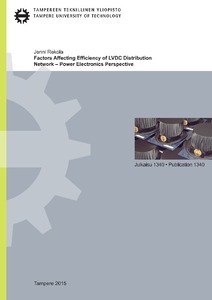Factors Affecting Efficiency of LVDC Distribution Network – Power Electronics Perspective
Rekola, Jenni (2015)
Rekola, Jenni
Tampere University of Technology
2015
Teknis-taloudellinen tiedekunta - Faculty of Business and Technology Management
This publication is copyrighted. You may download, display and print it for Your own personal use. Commercial use is prohibited.
Julkaisun pysyvä osoite on
https://urn.fi/URN:ISBN:978-952-15-3622-9
https://urn.fi/URN:ISBN:978-952-15-3622-9
Tiivistelmä
The power distribution network will be changed towards the future Smart Grid due to increased number of installed renewable power generation units to fulfill the tightened environmental regulation. The control of the future Smart Grid will be challenging due to increased number of renewable power generation units, which are variable in nature, and at the same time, the customers are highly dependent on uninterruptable, high quality power supply. The Smart Grid control is intensively studied. It can be concluded that the control might be simpler and the grid operation more reliable if the AC grid would be replaced by DC grid. However, the detailed energy efficiency analysis of the DC grid is not thoroughly studied. The efficiency and total lifetime costs are the key parameters when the network owners consider the future grid structure.
This thesis addresses the factors, which affect the energy efficiency of the low voltage DC (LVDC) distribution network from power electronics perspective. The power loss models for the converters and their AC filters are developed and verified by measurements. The impact on the converter topology, used power semiconductor switches, AC filter design and inductor core material, DC network configuration, customer behavior, the need of DC voltage balancing in the bipolar DC network as well as the grounding issues to fulfill the electrical safety standards are treated. For facilitating the design of cost effective LVDC distribution networks, the total power losses of the network with different configurations are evaluated and compared.
It is revealed that the used filter inductor core material has a significant impact on the power losses of the LVDC distribution network. The inductor core material having low high-frequency power loss characteristics, such as amorphous alloy, is recommended. The LVDC distribution network should be grounded to minimize the power losses whenever it is possible according to the local safety standardization and grounding conditions. The three-level NPC converters connected to 1500 VDC should be used to minimize the power losses. The grid-frequency isolation transformer is the main power loss source if the galvanic isolation is needed to isolate the ungrounded LVDC distribution network and the grounded customer electrical installations. In this case, the highest energy efficiency is achieved by using two- or three-level converters connected to 750 VDC if the DC cable length is less than 600 m. Otherwise, slightly higher energy efficiency is achieved by using three-level converters connected to 1500 VDC. Therefore, voltage transformation ratio of the isolation transformer must be 800V/400V instead of 400V/400V. Moreover, the efficiency of the power converters is increased by using SiC MOSFETs instead of conventional IGBTs as power semiconductor switches.
This thesis addresses the factors, which affect the energy efficiency of the low voltage DC (LVDC) distribution network from power electronics perspective. The power loss models for the converters and their AC filters are developed and verified by measurements. The impact on the converter topology, used power semiconductor switches, AC filter design and inductor core material, DC network configuration, customer behavior, the need of DC voltage balancing in the bipolar DC network as well as the grounding issues to fulfill the electrical safety standards are treated. For facilitating the design of cost effective LVDC distribution networks, the total power losses of the network with different configurations are evaluated and compared.
It is revealed that the used filter inductor core material has a significant impact on the power losses of the LVDC distribution network. The inductor core material having low high-frequency power loss characteristics, such as amorphous alloy, is recommended. The LVDC distribution network should be grounded to minimize the power losses whenever it is possible according to the local safety standardization and grounding conditions. The three-level NPC converters connected to 1500 VDC should be used to minimize the power losses. The grid-frequency isolation transformer is the main power loss source if the galvanic isolation is needed to isolate the ungrounded LVDC distribution network and the grounded customer electrical installations. In this case, the highest energy efficiency is achieved by using two- or three-level converters connected to 750 VDC if the DC cable length is less than 600 m. Otherwise, slightly higher energy efficiency is achieved by using three-level converters connected to 1500 VDC. Therefore, voltage transformation ratio of the isolation transformer must be 800V/400V instead of 400V/400V. Moreover, the efficiency of the power converters is increased by using SiC MOSFETs instead of conventional IGBTs as power semiconductor switches.
Kokoelmat
- Väitöskirjat [4773]
